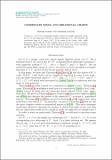| dc.contributor.author | Fomin, Sergey | |
| dc.contributor.author | Lusztig, George | |
| dc.date.accessioned | 2022-10-07T17:13:01Z | |
| dc.date.available | 2022-10-07T17:13:01Z | |
| dc.date.issued | 2022-01-05 | |
| dc.identifier.uri | https://hdl.handle.net/1721.1/145770 | |
| dc.description.abstract | Let G be a semisimple simply connected complex algebraic group.
Let U be the unipotent radical of a Borel subgroup in G. We describe the
coordinate rings of U (resp., G/U, G) in terms of two (resp., four, eight)
birational charts introduced by Lusztig [Total positivity in reductive groups,
Birkh¨auser Boston, Boston, MA, 1994; Bull. Inst. Math. Sin. (N.S.) 14 (2019),
pp. 403–459] in connection with the study of total positivity. | en_US |
| dc.language.iso | en | |
| dc.publisher | American Mathematical Society (AMS) | en_US |
| dc.relation.isversionof | 10.1090/ert/592 | en_US |
| dc.rights | Article is made available in accordance with the publisher's policy and may be subject to US copyright law. Please refer to the publisher's site for terms of use. | en_US |
| dc.source | American Mathematical Society | en_US |
| dc.title | Coordinate rings and birational charts | en_US |
| dc.type | Article | en_US |
| dc.identifier.citation | Fomin, Sergey and Lusztig, George. 2022. "Coordinate rings and birational charts." Representation Theory of the American Mathematical Society, 26 (1). | |
| dc.contributor.department | Massachusetts Institute of Technology. Department of Mathematics | en_US |
| dc.relation.journal | Representation Theory of the American Mathematical Society | en_US |
| dc.eprint.version | Final published version | en_US |
| dc.type.uri | http://purl.org/eprint/type/JournalArticle | en_US |
| eprint.status | http://purl.org/eprint/status/PeerReviewed | en_US |
| dc.date.updated | 2022-10-07T17:09:02Z | |
| dspace.orderedauthors | Fomin, S; Lusztig, G | en_US |
| dspace.date.submission | 2022-10-07T17:09:03Z | |
| mit.journal.volume | 26 | en_US |
| mit.journal.issue | 1 | en_US |
| mit.license | PUBLISHER_POLICY | |
| mit.metadata.status | Authority Work and Publication Information Needed | en_US |
